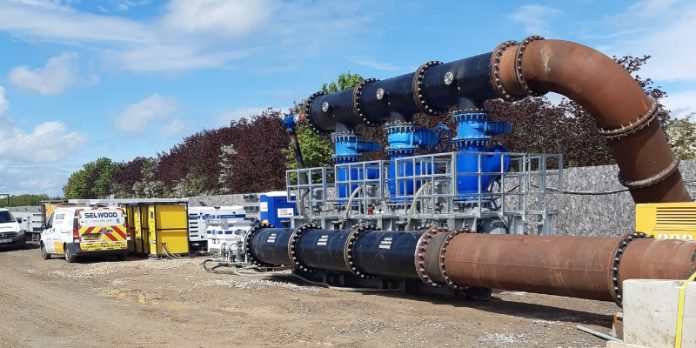Steve Walker, Selwood
The Background
As part of a £1.2billion upgrade programme, Network Rail is increasing capacity for passenger trains on the East Coast Main Line by building a new two-track railway line that dives under the line at Werrington, north of Peterborough. The new portal crossing will remove constraints to the timetable caused by slower freight trains on the Great North Eastern route, which currently have to cross over the high-speed East Coast Main Line.
The “dive under” structure is a curved box built next to the main line which weighs more than 11,000 tonnes – 1,000 tonnes heavier than the Eiffel Tower. It was pushed under the East Coast Main Line using large jacks to propel and steer it into place, in January 2021. This is the first time a curved concrete box has been installed using this industry-leading technique in the UK.
Part of the route included a surface water sewer line which needed to be diverted to allow the works to take place. Principle contractor, Morgan Sindall Infrastructure, called upon Selwood’s pump rental specialists to help with this process.
The Challenge
Selwood’s role was crucial in allowing the works to take place, ensuring the site, and a nearby industrial estate, weren’t flooded. The nature of the project meant that there would be no opportunity to revisit pipework installed over the line – so a completely leakproof solution without joints in the stretch of pipework over the crossing was required.
The Solution
The project was to divert flows so the old surface sewer could be redirected and to construct a new pumping station, allowing for the construction of the new route under the railway line. After a site visit, Selwood’s engineering teams used Revit computer-aided design to model the solution and identify any potential problems.
The solution was to cut into the sewer, install an 18-metre section of 700mm pipework across the new railway line at the site of the portal crossing and use pumps to divert the flows of the existing sewer into a nearby brook.
Selwood’s teams specified and installed an electric-driven S150 pump to handle normal dry weather flows. The electric model was chosen because it is quieter and produces far lower emissions than a diesel-driven equivalent.
The 18-metre section of pipework had to be ordered in especially for the project because of the length required. The joints were positioned either side of the portal crossing with a seamless stretch of pipework over the site of the new line. This solved the problem of the lack of access to pipework.
To cope with wet weather flows, three CZ3501 pumps were set up in a duty/assist/standby configuration, with the standby on hand to start in the event of the failure of the duty or assist pumps. Selwood’s telemetry systems were used to monitor the performance of the setup, while auto stop/start systems ensured pumps were only run when needed for further cost efficiency and to minimise emissions.
The Result
The works were successfully carried out to schedule and time was made up to compensate for the delays experienced. The solution worked perfectly without leaks and without any need for the standby pump to be used.



